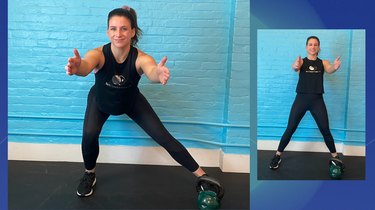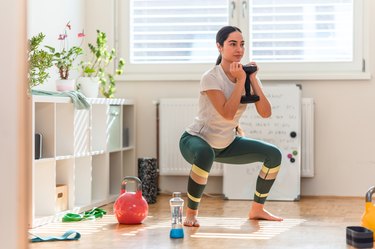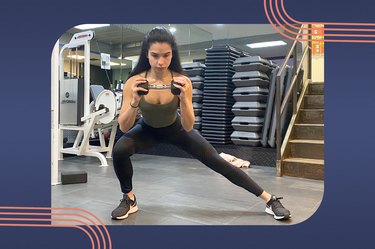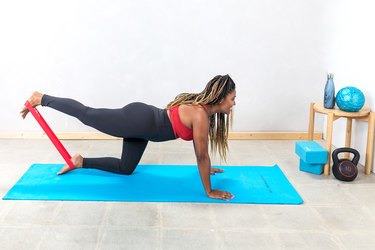

Even if squats are a star in your lower-body workout, we're guessing lateral squats (aka side squats) aren't — at least not yet. The side-to-side version of the functional move deserves more love and attention that it currently gets.
Why? Because it works the entire lower-body — quads, glutes, hamstrings, hip adductors and abductors — while also challenging your core strength and stability. That's a whole lot of benefit from one single move.
Video of the Day
- What is a lateral squat? It's a lower-body exercise that involves standing with your feet shoulder-width apart, hinging forward at the hips, shifting to one side and bending the knee to squat on that leg, while keeping the other leg straight. You then shift back to standing.
- What muscles do lateral squats work? "They work your quadriceps, hamstrings, adductors, abductors, and glutes—AKA the legs, butt, and inner/outer thighs," says Tatiana Firpo, CPT, a certified personal trainer and group fitness instructor in New York City. They also require some serious core engagement to perform properly. You can benefit from doing them with just your bodyweight, but adding weights ups the resistance and strength-building benefits.
- What are the benefits of a lateral squat? They target your inner and outer thighs more than regular squats. Plus, because so many standard exercises have you moving in a forward-and-back or up-and-down direction, side squats give you the chance to reduce side-to-side muscle imbalances.
How to Do Lateral Squats With Perfect Form

- Stand with your feet together, abs engaged and your back straight. Extend both arms in front of you for balance or clasp your hands together in front of your chest.
- Step your right foot out to the right about two to three feet. Bend your right knee and lower your hips toward the floor into a squat position, while keeping your left leg straight.
- Press through your right foot to return to the starting position.
- Repeat on the other side.
Watch the Full Tutorial
Tip
You can do the lateral squat with dumbbells, kettlebells, a TRX, barbell, sandbags, resistance bands, a box or chair and even battle ropes, says Christine Torde, CPT, a strength coach at Body Space Fitness in New York City.
Because you can use so many different types of equipment and levels of resistance, it’s easy to modify the move for any fitness level and goal.
Scroll down for three popular side squat variations.
What Is the Difference Between a Lateral Lunge and Lateral Squat?
"A lateral lunge or side lunge and a lateral squat are very similar; however, a lateral lunge is different because there is more locomotion," Torde says. "You are stepping into the lateral lunge rather than shifting back into it. Because your feet move, the lateral lunge is more dynamic and requires a bit more stability and coordination."
Both exercises target the same muscles in the legs and glutes, but because of the stability challenge, the lateral lunge works the core a little bit more. You can also think of the side squat as a no-impact version of the side lunge, Firpo says.
4 Lateral Squat Benefits and Muscles Worked
1. It Builds Your Glutes
The lateral squat targets the glute maximus, which is the largest glute muscle. This muscle plays a huge role in any squat because it's the biggest and strongest butt muscle — the real powerhouse of your lower body.
Because you're moving from side to side, the move also targets the muscles on the outside of the glutes — specifically, the glute medius and glute minimus, Torde says. These are known as the hip abductors muscles, because their job is hip abduction, or moving the leg laterally away from the midline of the body.
Note: Strengthening these muscles is huge for injury prevention, as strong side glutes improve alignment in and reduce stress on your hips, knees and ankles.
2. It Strengthens Your Legs
Your legs will also put in a good bit of work during the side-to-side squat, similarly to a basic squat. You'll feel your quad muscles working hard, alongside your glutes, as you sink into the move and when you press through the floor to return to standing, she says.
The calves and hamstrings get in on the fun too, though they're not the major movers here.
3. Stretches and Tones Your Inner Thighs
The muscles of the inner thighs are also known as the hip adductors. They do the opposite of the abductors, and help you squeeze your legs together.
When you sink into each rep, you should feel a nice stretch in these inner thigh muscles, Torde says.
As you move from the squat back up to the standing position, you use these muscles to bring your body back toward center, giving you a good inner thigh workout.
4. Engages Your Core
A lateral squat is a compound movement, which means that it uses multiple major muscle groups at once. Even though you won't feel a burn in your core muscles like you would during a plank, your core is working the entire time to keep your body stable.
Because you're moving from side to side here, your obliques — ab muscles that run along the sides of your torso — will be doing some extra work, too.
7 Tips for Better Results
1. Perfect Your Stance
If your stance is too wide, you run the risk of overextending and putting too much pressure on your knee; if your stance is too narrow, you won't be able to fully hinge back and bend your knee into a deep enough squat.
You want to stand with your feet wide enough that your tibia (shin bone) lines up straight over your ankle and below your knee when you shift to the side and lower into a lateral squat. If your leg doesn't stack like that, change your stance until it does.
2. Sit Back, Not Forward
As you move to the side and begin to sink into your side squat, you may be tempted to lean forward or even go up onto your toes. This is a good way to put too much pressure on your knee — plus, you're taking some of the work off your glutes, so you won't work them as much (which is kinda the goal of this whole exercise!).
To avoid drifting forward, focus intentionally on sitting back and keeping your entire foot on the ground as you bend your knee and hinge at the hips, almost as if you're trying to slowly sit back onto a chair. Except, you're not, because your butt is working hard to hold your weight and then press you back up when you come out of the side squat.
3. Watch Your Knee Alignment
One common mistake people make doing lateral squats is letting the knees cave in or press too far out, Torde says. "If the knee collapses in or presses outside of our body, this could lead to injury." It might not hurt immediately, but over time, pressing on the knee in this way could lead to issues.
"It really should look like one side or half of a standard squat," Firpo says.
Think about keeping your knee facing forward and in line with the second or third toe, Torde says. "A good fix is to look at yourself in a mirror to check your form. (FYI, recording yourself on your phone also works.)
Also, if you find your knee keeps wanting to cave in or press out, it could mean you need to work on improving your knee stability in general. "Try holding onto a TRX or cable to have additional support while performing the movement to practice before doing it unassisted," she says.
4. Keep Your Straight Leg Fully Straight
When shifting to one side, the opposite leg should remain straight. If not, it can be difficult to shift back to the center standing position, Torde says.
This can prevent you from getting the full benefits of the exercise — the bulk of the glute work happens when you press through the foot of the bent leg and shift back to the middle, so you want that movement to be smooth. A bent leg can interrupt the flow and change how you shift your weight.
"If you have trouble keeping this opposite leg straight, you might need to regress the depth of your lateral squat or use a prop to help maintain control," she says.
5. Keep Your Chest Up and Spine Straight
Rounding the spine is a common mistake people make doing side squats, Firpo says. This can also mean your chest collapses forward. Doing this can put undue stress on your back and knee (especially if you're holding weights) and reduce the exercise's effects on the glutes.
To correct this, Firpo suggests thinking about sitting your hips and tailbone back and shifting the weight toward your heels. "Imagine sitting down in a chair, and think about maintaining 'good' posture and an elongated spine. Pull your navel in towards your spine, engaging your core," she says. "Watching yourself in the mirror can help!" Another good cue is to keep your eyes forward and up slightly so that your body follows your vision and your chest remains upright.
6. Engage Your Core
Lateral movements require a decent amount of core stability and control. To move most effectively and keep your back straight, make sure you're engaging your core throughout the entire movement. If you don't, you can end up arching your lower back or rounding your upper back, both of which can cause pain (or injury if you're lifting heavy weights).
7. Progress Slowly
If you're new to strength training, start with the body- weight version first. Once you've mastered the form, add weights that feel challenging but doable. Avoid using weights that are too heavy to allow you to complete the exercise with proper form. If you have trouble shifting back up to standing and feel you have to arch or twist your back or bend your straight leg, the weight is probably too heavy.
"If you find that it's too challenging, uncomfortable or even painful, do not continue," Firpo notes. "You may need to either work on form, or work on your range of motion." Working with a fitness professional can help you figure out which muscles are too weak or tight, preventing you from proper execution, she says.
3 Lateral Squat Variations
Move 1: Dumbbell Lateral Squat
- Stand with your feet together, abs engaged and your back straight. Hold a dumbbell in each hand down at your sides with your palms facing in.
- Step your right foot out to the right about two to three feet. Bend your right knee and lower your hips toward the floor into a squat position, while keeping your left leg straight. The dumbbells should lower to both sides of your bent leg.
- Press through your right foot to return to the starting position.
- Repeat on the other side.
Move 2: Kettlebell Goblet Lateral Squat
- Stand with your feet together, abs engaged and your back straight. With both hands, hold a kettlebell by the bell at your chest.
- Step your right foot out to the right about two to three feet. Bend your right knee and lower your hips toward the floor into a squat position, while keeping your left leg straight.
- Press through your right foot to return to the starting position.
- Repeat on the other side.
Move 3: Dumbbell Goblet Lateral Squat
- Stand with your feet together, abs engaged and your back straight. With both hands, hold a dumbbell by one end at your chest.
- Step your right foot out to the right about two to three feet. Bend your right knee and lower your hips toward the floor into a squat position, while keeping your left leg straight.
- Press through your right foot to return to the starting position.
- Repeat on the other side.


